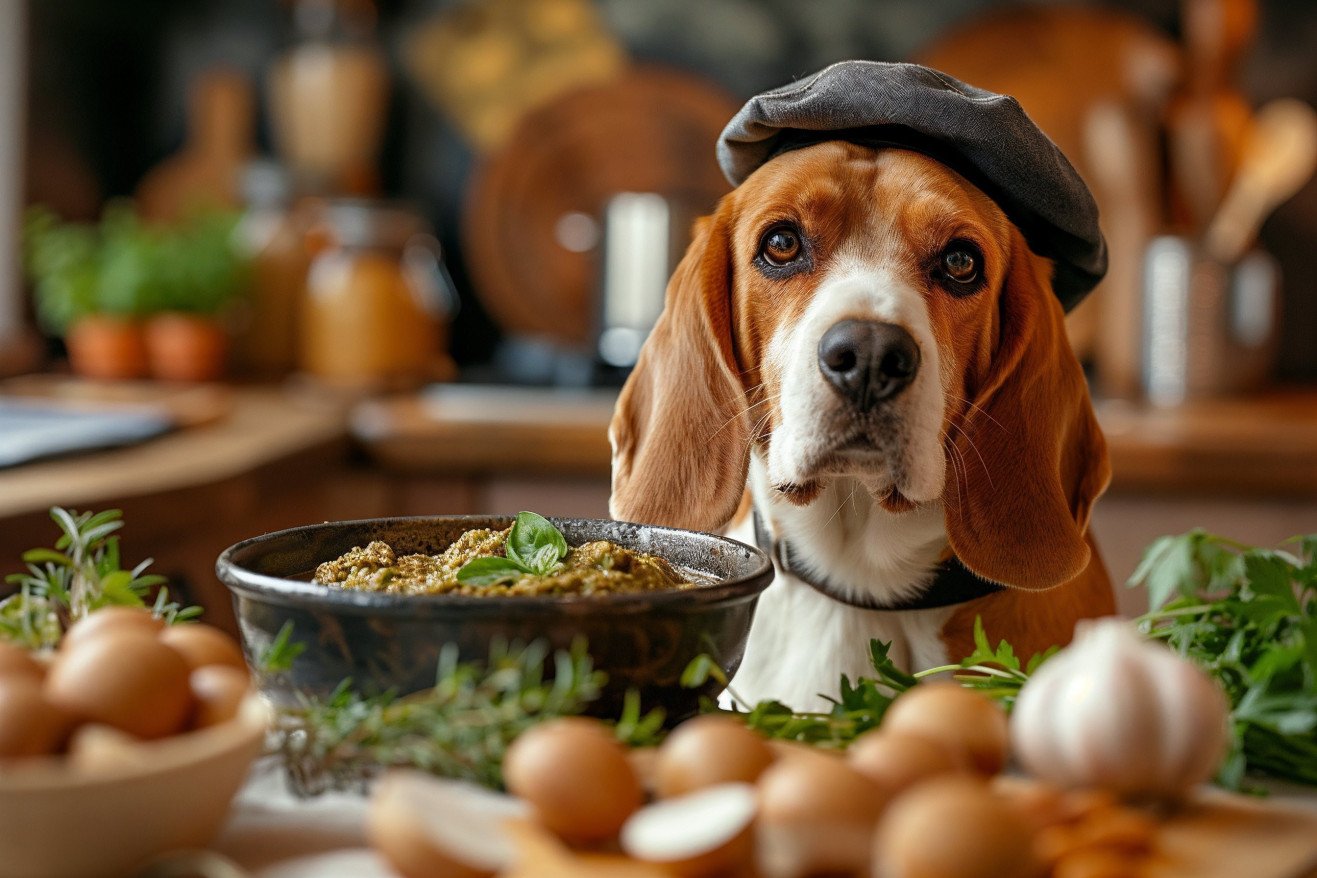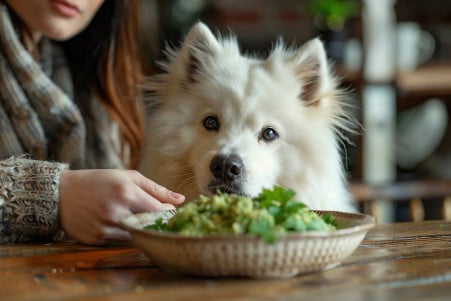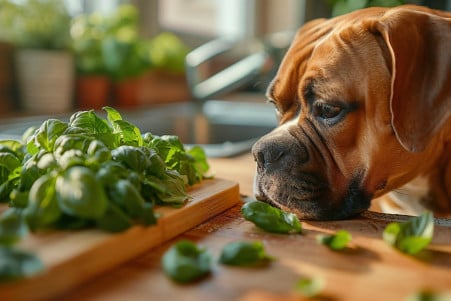Can Dogs Eat Pesto? Understanding the Risks and Safe Alternatives
11 February 2024 • Updated 10 February 2024

Pesto is a delicious addition to many meals, but is it OK for dogs to eat? Unfortunately, many of the ingredients in pesto, including garlic, which is toxic to dogs, mean that traditional pesto is not safe for dogs. In addition, the high levels of salt and fat in pesto can be dangerous for dogs. As a result, it’s best to avoid giving dogs store-bought or homemade pesto.
This article will delve into the subtleties of dog nutrition, examining research and expert opinions to clarify how the ingredients in pesto can affect a dog’s health.
We’ll also look at the biological differences between dogs and humans that can impact what dogs can and can’t eat. By reviewing these research-based perspectives, you’ll come away with a better understanding of what’s safe and unsafe for your dog to eat.
Can dogs eat pesto?
Why Pesto Is Bad for Dogs
Pesto is a popular sauce that many people love, but it contains ingredients that are toxic to dogs. Garlic, which is often used in pesto, is especially dangerous for dogs because it contains compounds that can cause damage to their red blood cells and lead to anemia.
In fact, Pure Pet Food points out that garlic and onions—another member of the Allium family that’s sometimes used in pesto—can cause gastrointestinal problems and oxidative damage in dogs, which can lead to hemolytic anemia, a condition that can be fatal.
Another issue with traditional pesto is that it’s high in fat, thanks to ingredients like olive oil and pine nuts. It’s well-documented that dogs can’t handle high-fat diets, which can result in pancreatitis, a painful and potentially life-threatening inflammation of the pancreas, and other digestive problems. In addition, some pesto recipes include nuts like walnuts and macadamia nuts, both of which are toxic to dogs.
Finally, while the cheese in pesto isn’t toxic, it’s high in fat and salt, which can cause problems for dogs with heart and kidney issues, according to Pure Pet Food.
If a dog eats pesto, symptoms to look out for include lethargy, pale gums, vomiting, and diarrhea, and it’s important to get the dog to a vet right away. This is especially true because symptoms of garlic toxicity may not show up right away.
This is why it’s so important to make sure we’re feeding our pets a diet that’s tailored to their biological needs and avoiding human foods that can be harmful to them.
Canine Metabolic Capabilities: Why Dogs Can’t Eat Pesto
Dogs and humans have different metabolic pathways, especially in terms of fat and starch metabolism. Studies have shown that a high-fat diet results in increased blood glucose concentrations and a higher glucose/insulin ratio in dogs, which can impact their metabolic health.
On the other hand, starches have been shown to have a different effect on dog metabolism, increasing lipid metabolism and providing anti-oxidative effects. Because of these different reactions, it’s easy to see why dogs have specific dietary needs and limitations in their digestive systems.
Studies have gone even further to explain the issue by showing that dogs can’t synthesize certain amino acids and have unique dietary requirements for others, including taurine and arginine, which are essential for their health. These physiological differences explain the dietary tolerances and limitations in dogs. The ingredients in pesto, including garlic and high-fat nuts, are not metabolically appropriate for dogs, which is why they are toxic to them.
Making sure that we feed our dogs diets that are in line with their metabolic capabilities is about more than just avoiding immediate health problems—it’s about setting them up for long-term health. As we think about what we can feed our dogs from our plates, it’s important to understand the importance of species-appropriate options.
How to Make Pesto for Dogs
In order to make pesto safe for dogs, you need to swap out the ingredients that are toxic to dogs for ingredients that are safe for them to eat. Instead of garlic, you can use a few leaves of basil, which Rover says is high in antioxidants and has antiviral and antimicrobial properties, which can help with arthritis and stress.
Instead of pine nuts, you can use a single Brazil nut, which Modern Dog Magazine says is a good source of selenium and is safe for dogs in small amounts.
For a basic dog-friendly pesto, blend 1 cup of parsley, which is known for its detoxifying properties, with a few shavings of Parmesan (which should be used sparingly to keep the fat and salt content low), and a Brazil nut until the mixture is finely ground. This pesto will give your dog a tasty treat that also has some health benefits, including fresher breath and a nutritional boost.
While these substitutions do provide some health benefits, it’s important to remember that they should be used in moderation. Even healthy ingredients can cause digestive upset or nutritional imbalances if they are fed to your dog in excessive amounts.
And, as always, make sure to check with your vet before adding any new foods to your dog’s diet to make sure that they are safe for your pet based on their individual health concerns and dietary needs.
How to Create a Healthy Diet for Your Dog: Nutritional Requirements and Foods to Steer Clear Of
Knowing what your dog needs to eat and what they should avoid is essential to their overall well-being. According to WebMD, a healthy diet for dogs includes a combination of proteins, carbohydrates, fats, vitamins, minerals, and water.
Proteins and fats provide energy and help maintain healthy skin, while carbohydrates provide fiber for digestion. Dogs can make their own vitamin C, but they need other vitamins and minerals to help with chemical processes, including bone formation.
That said, not all human foods are safe for dogs. The American Kennel Club (AKC) lists garlic and macadamia nuts as examples of human foods that are toxic to dogs. The AKC also notes that while some fruits and vegetables can be good for dogs, others, like grapes and raisins, can cause kidney failure.
The ASPCA says that dogs should avoid foods that are high in salt and sugar, as well as certain dairy products, because they can cause health problems. However, the ASPCA also says that these foods are fine in moderation.
By knowing which foods are good for your dog and which ones can be harmful, you can make the best choices for your pet. This way, you can avoid harmful foods and use your dog’s diet to improve their overall well-being.
Final Thoughts: Know Your Dog’s Dietary Needs
To sum it up, classic pesto, with all of its deliciousness, should be kept to humans only because of the garlic and high-fat ingredients that it contains. Because of the differences in the way that our bodies work, what is safe for humans can be toxic for dogs. Garlic and high-fat nuts can lead to a variety of health problems in dogs, from digestive issues to more serious problems like pancreatitis and hemolytic anemia.
This article has shown how important it is to understand the dietary needs of dogs and the dietary restrictions that are specific to them. It’s also important to understand that while we love having our pets in our lives, we can’t always share everything with them. By offering dog-friendly options and understanding the basics of a well-rounded dog diet, we can make sure that our pets are happy and healthy.
Always consider the potential impact of a new food on your dog’s health and talk to your vet before making any changes to their diet. This way, we can make sure that we’re taking the best care of our furry friends and keeping them as happy and healthy as possible.


